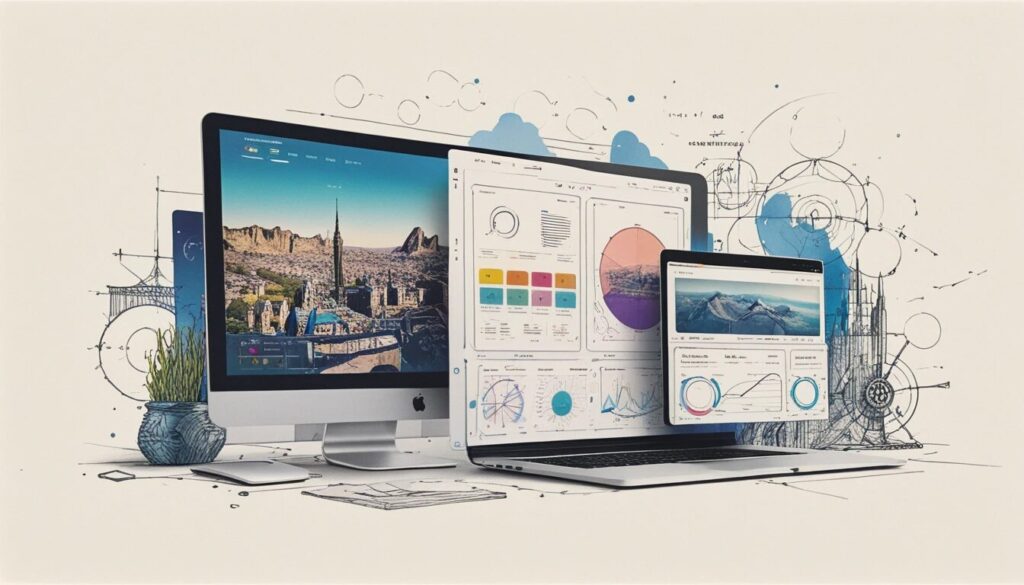The Future of UX/UI: A Design Revolution in 2025
UX/UI design is no longer just about making things look pretty; it’s a full-fledged psychological chess game played between users and interfaces. As we step into 2025, designers are wielding AI like a magic wand, bringing interfaces to life with animations, and crafting experiences so intuitive they might just read your mind. If you thought design trends in 2024 were groundbreaking, buckle up—because what’s coming next is nothing short of revolutionary.
AI-Integrated Design Trends 2025: The Robot Overlords of UX
- AI streamlining repetitive tasks, allowing designers to focus on creativity.
- Automated UX research and user behavior predictions.
- AI-powered design tools generating layouts and components.
The future of UX/UI is less about pushing pixels and more about letting AI do the heavy lifting. AI-integrated design tools are stepping in to automate the mundane, leaving designers free to focus on what truly matters—making users feel like they’re interacting with a sentient, all-knowing interface. From generating responsive layouts to conducting A/B testing in real time, AI is revolutionizing design workflows. Platforms like UXPin have already introduced AI-powered features to streamline design complexity, proving that the robots might not take our jobs—just the boring parts of them.
Cross-Platform UX Strategies 2025: The Seamless Experience We Deserve
- Personalized content across different devices.
- Responsive interfaces that adapt to screen sizes dynamically.
- Unified UX principles across mobile, desktop, and emerging platforms.
Gone are the days when apps looked like they were coded by two different species depending on whether you accessed them on mobile or desktop. Cross-platform UX strategies in 2024 have made sure that whether you’re using a smartwatch, a tablet, or even a fridge with a screen, your experience is consistent. Instagram, for instance, has enhanced its desktop version to accommodate larger monitors, while YouTube is blending mobile-friendly vertical content into its desktop interface. The goal? A seamless transition across devices so smooth, you won’t even notice it happening.
Animated Icons in UI Design: Because Static is Boring
- Dynamic icons enhancing user engagement.
- Subtle animations providing visual feedback.
- Integration of motion design into UI elements.
Why settle for static icons when you can have tiny moving works of art? Animated icons in UI design are becoming the norm, offering feedback, guiding users, and simply making interfaces more delightful. Apple’s iOS17 has fully embraced this trend, injecting life into every tap and swipe. Whether it’s a bouncing download button or a pulsating heart icon, motion design is the new standard for intuitive, engaging interactions.
3D Visual Elements in UX/UI: Adding Depth to Digital
- Immersive 3D experiences redefining digital interaction.
- Enhanced data visualization using three-dimensional elements.
- 3D design blending with augmented and virtual reality.
Flat design? That’s so 2019. In 2025, 3D visual elements in UX/UI are taking over, transforming interfaces into immersive landscapes. Whether it’s complex data visualization or interactive product previews, 3D elements create a sense of depth and realism that pulls users in. This trend is especially booming in VR applications, where lifelike environments are no longer just a gimmick—they’re essential to user engagement.
Emotionally Intelligent Design Principles: Tech That Feels
- Interfaces that adapt to users’ emotions and behaviors.
- Empathetic design elements improving user experience.
- AI-driven personalization creating human-like interactions.
Move over, cold and robotic interfaces—emotionally intelligent design principles are making tech feel more human. Whether it’s a chatbot that detects frustration and adjusts its tone or an interface that subtly shifts color based on user stress levels, UX is becoming more intuitive than ever. This emotional awareness ensures technology doesn’t just serve users but actually understands them. The result? A digital experience that feels eerily personal, like your favorite barista remembering your coffee order before you even say a word.
The Typography Takeover: Big, Bold, and Unapologetic
- Oversized fonts making bold design statements.
- Mixing typefaces for visual contrast and emphasis.
- Typography-driven UI layouts replacing traditional design elements.
In 2025, subtlety is out, and typography is having a main-character moment. The trend? Big, bold, and capitalized fonts that demand attention. Websites like Awwwards are leading the charge, proving that oversized typography isn’t just a design choice—it’s a power move. Brands are using varied typefaces to emphasize specific words, ensuring that even if users skim, they still get the message loud and clear. If design is about communication, then typography is screaming.
The UX/UI Evolution Continues
UX/UI design in 2025 is a thrilling blend of AI sophistication, animated flair, and emotionally intelligent interactions. The rise of AI-integrated design, cross-platform UX strategies, and animated icons is shaping a future where interfaces are not just functional—they’re practically alive. Whether you’re a designer, developer, or just someone who appreciates a well-crafted interface, these trends ensure that digital experiences remain engaging, intuitive, and, most importantly, human. The only question left is—are you ready to embrace the future of design?
